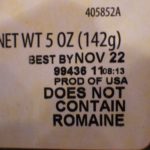 Yes, you’ve probably heard there is another recall of ROMAINE lettuce. It was obvious when our local grocery store pulled all the products that contained romaine. The shelves looked empty.
Yes, you’ve probably heard there is another recall of ROMAINE lettuce. It was obvious when our local grocery store pulled all the products that contained romaine. The shelves looked empty.
This is the fifth such recall due to E.coli O157:H7 since late 2017.
According to a Food Safety News article https://www.foodsafetynews.com/2019/11/letter-from-the-editor-lets-call-the-whole-thing-off/ over 360 people have been infected during these outbreaks with many hospitalizations and at least six deaths.
This recall started with packaged salads but now expanded to all ROMAINE lettuce grown in
the Salinas, California area. Read your labels. Many are now saying where the lettuce was grown. If the package contains ROMAINE but you don’t know the origin, don’t take chances. The package I had in my refrigerator just said product of the US but also emphasized it did NOT contain any Romaine.
The same goes for salads in restaurants and salad bars. Ask the staff —hopefully, their suppliers have verified where the lettuce was harvested. If they don’t know, don’t take a chance.
E.coli O157:H7 is a nasty bacterium that can lead to potentially life-threatening kidney failure —especially in young children, the elderly and those with compromised immune systems. For many years we’ve associated these bacteria with undercooked ground beef. But these recent recalls show that ROMAINE is also a major potential source. The pathogen is killed by sufficient heat but obviously, since lettuce and salads aren’t cooked they have become a source. This is not something that you can wash off the lettuce.
E.coli O157:H7 has also been associated with unpasteurized (raw) milk and juice, soft cheeses made from raw milk, and raw fruits and sprouts. It has also recently been linked to raw flour.
Right now the recall is ONLY for ROMAINE lettuce (whole heads, hearts, salad mixes with romaine, baby romaine and Caesar salad mixes). Other leafy greens have NOT been implicated.
The recall is ONLY for the Salinas, California growing region. This includes Santa Cruz, Santa Clara, San Benito, and Monterey counties in California.
Cheryle Jones Syracuse, MS
Professor Emeritus, The Ohio State University
FMI – see GREEN IDEAS
References:



